
LED lighting for multi-sports fields, gymnasiums, or multi-sports halls requires taking into account all the sports practices of the room. The sizing and positioning of the lighting must meet the comfort of the players, but also the lighting standards for Handball, Basketball, Volleyball, Badminton, or other sports practices on the site.
The lighting standards for multi-sports halls are varied. Indeed, everything depends on the sports practiced in your gymnasium.
First of all, there is the general lighting standard NF EN 12193, as well as all the lighting recommendations corresponding to the sporting activities of the multi-sports hall.
For example, if basketball, handball and badminton can be played, we will recommend the best solution that will meet the standards in force for each discipline.
We also take into account the floor covering, whether it is resin, synthetic, parquet or porous concrete (old multi-sports halls), to adapt the light accordingly. Indeed, each covering reflects light differently, this can therefore affect the layout, number or even the power of the lights to be installed.
In a sports “relamping” project in a gymnasium, the installed projectors are often old iodide or mercury models. These luminaires consume a lot of energy and are not operational as soon as they are switched on. Indeed, they require a period of time during which their light intensity gradually increases to its maximum.
Unlike this type of lighting, LED projectors do not need a preheating time to be at their maximum power and their consumption is approximately 2 times lower. They also allow immediate extinction and re-ignition.
To complete our statements, we invite you to browse our sports lighting guide bringing together all our lighting advice for each sports facility.

This is our most versatile range of floodlights, making it ideal for lighting gymnasiums due to the many sports that can be played. These lighting fixtures can also be found on tennis courts or as a complement to Goliath floodlights on football or rugby pitches.
This choice is obviously not random, in fact, its 4 powers ranging from 100 to 400W and its luminous efficiency of 160lm/W will allow you to adapt according to the standards of the sports practiced in your multi-sport hall.
In order to ensure that the entire playing area is lit according to the standards in force, the projector modules can be tilted at different angles and diffuse the light according to different optics, all recommended by our specialized design office.
This set of characteristics will allow you to meet the different standards of the French sports federations, regardless of the initial installation of the lighting supports in the case of a gymnasium relamping.
Often, we find the Eros in many renovation projects. Indeed, the lighting lines are already in place, this allows to ignore the step of installing the electrical wiring. Thus, all that remains is to connect them and the lighting is ready!
As mentioned above, they are very practical for relamping projects with zenithal lighting, i.e. perpendicular to the ground.
It can also be found in very specific installation projects where zenithal lighting is optimal for practice. For example, in table tennis, boxing, dance or bodybuilding rooms, this type of lighting is perfectly suited to practice knowing that you do not necessarily need to look up.
With its 120W and 200W powers, its high luminous efficiency of 160 lm/W, these symmetrical diffusion angles of 90° or 60° and the rotation capacity of its bracket, the Eros LED linear will adapt according to the areas to be lit and the standards to be respected.
The Olympe and Eros LED luminaires are respectively certified IP66 and IP20 (protection ratings against humidity and dust) and IK10 (protection rating against shocks). They will therefore be protected against water in the event of condensation inside the gymnasium, against dirt and against any stray ball that would collide with a floodlight.
The lighting of a gymnasium or a multi-sport hall is governed by the Afnor NF EN1293 standard which defines the brightness levels according to the competition levels of the different sports.
In general, we work mainly on 3 levels:
750 Lux average for the national level
500 Lux average for regional level
300 Lux average for the departmental level
| Brightness Emoy |
Brightness Emin/Emoy |
Handball | Basketball | Volleyball | Badminton | Tennis | |
| National | 750 Lux | ≥ 0,7 | Class I / II | H3 | I | I | International |
| Regional | 500 Lux | ≥ 0,7 | Class III / IV | H2 / H1 | II | II | Competition |
| Departmental | 300 Lux | ≥ 0,7 | Class V | H1 | III | III | Training |
| Number of measurement points on the frame | 14 points | 13 points | 10 points | 6 points | 24 points | ||
For gymnasiums or multi-sports halls, there are no real standard dimensions. They vary depending on whether it is an old gymnasium or a hall equipped with stands.
In the many projects we study, 2 dimensions come up regularly :
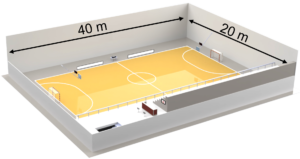
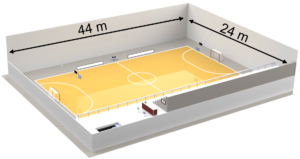
Handball, basketball, volleyball and badminton courts are standardized courts in terms of their dimensions. Find them below :
| Type of multi-sport hall | Departmental | Regional | Interregional | National | International |
| Badminton | 15.2 x 6.9 x 9m | 15.2 x 7.3 x 9m | 19.4 x 12.1 x 12m | ||
| Basket-Ball existing room |
32 x 20.5 x 7m | 38 x 27 x 7m | |||
| 28 x 18.5 x 7m | 30 x 18 x 7m | – | – | ||
| Volley-Ball | 28 x 17 x 7m | 32 x 19 x 9m | 40 x 25 x 12.5m | ||
| Futsal | 36 x 19.7 x 5m | 40 x 22 x 7m | 44 x 25.7 x 7m | – | |
| Handball | 44 x 23.7m | 44 x 25.7m | |||
The dimensions of a handball field:
In a multi-sport hall, a handball field is the largest of the playing fields. Its dimensions are 40×20 m. It is necessary to have a circulation corridor around at least 1m. In small halls (gymnasium with a dimension of 40x20m) which are often halls built many years ago, the handball field measures 38×18 m.
Survey grid of lighting points for handball:
For handball fields, the photometric survey grid defined by the French Handball Federation (FFH) includes 14 measurement points.
Regulations: The survey of light intensity is established on 14 points of the playing area measured one meter from the ground. For satisfactory illumination, the uniformity coefficient (C.U.) cannot be less than 0.7. It is calculated by dividing the minimum point recorded by the arithmetic mean of the 14 points.
Levels : Class I : 1200 Lux ; Class II : 750 Lux ; Class III and IV : 500 Lux ; Class V : 300 Lux
The dimensions of a basketball court:
In a multi-sport hall, a basketball court measures 28×15 m.
On a site where basketball is the dominant sport, the lighting can be located: either bilaterally or overhead, this has no impact on the practice and comfort of the players.
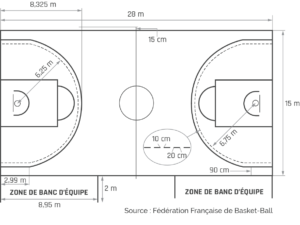
Lighting Point Survey Frame for Basketball:
For basketball courts, the photometric survey frame defined by the French Basketball Federation (FFB) includes 13 measurement points.
Regulations: The light intensity survey is established on 13 points of the playing area measured at ground level. For satisfactory illumination, the uniformity coefficient (C.U.) cannot be less than 0.7. It is calculated by dividing the minimum point surveyed by the arithmetic mean of the 13 points.
Levels: H1 : 300 Lux for old halls and 500 Lux for new constructions / H2 : 500 Lux / H3 : 750 Lux
The dimensions of a volleyball court :
In a multi-sports hall, a volleyball court measures 18×9 m. Very often, several volleyball courts are arranged in the multi-sports hall. The general analysis is done on the main court often positioned in the center of the hall.
On a site where the sporting dominance is volleyball, it is imperative not to position lighting above the playing area, unless they are located more than 9m high. For the comfort of the players, who regularly have their heads in the air, it is imperative to pay attention to the positioning of the light sources and their diffusion. Our Eros luminaire is ideal for this practice.
Lighting point survey grid for Volleyball :
For volleyball courts, the photometric survey grid defined by the French Volleyball Federation (FFV) includes 10 measurement points.
Regulations: The light intensity survey is established on 10 points of the playing area measured at ground level. For satisfactory lighting, the uniformity coefficient (C.U.) cannot be less than 0.7. It is calculated by dividing the minimum point surveyed by the arithmetic mean of the 13 points.
Levels : Departmental : 300 Lux, Regional : 500 Lux, National : 750 Lux and International : 1000 Lux.
It is imperative not to place any light source above the playing surface, and to avoid any dazzling sources.
The dimensions of a badminton court :
In a multi-sports hall, a badminton court measures 13.40 x 6.10 m. Very often, several badminton courts are arranged in the multi-sports hall. The layout and location of the courts vary depending on the size of the hall.
On a site where the dominant sport is badminton, it is imperative not to position lighting above the playing area, unless they are located more than 9m high. For the comfort of the players, who regularly have their heads in the air, it is imperative to pay attention to the positioning of the light sources and their diffusion.
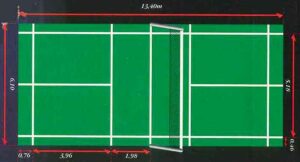
Lighting point survey grid for badminton :
For badminton courts, the photometric survey grid defined by the French Badminton Federation (FFBad) includes 10 measurement points.
Regulations: The light intensity survey is established on 10 points of the playing area measured at ground level. For satisfactory lighting, the uniformity coefficient (C.U.) cannot be less than 0.7. It is calculated by dividing the minimum point surveyed by the arithmetic mean of the 13 points.
Levels : Departmental : 300 Lux, Regional : 500 Lux, National : 750 Lux and International : 1000 Lux.
It is prohibited to position luminaires above the playing surface.
It is imperative not to place any light source above the playing surface and to avoid any glare sources.
The table tennis playing area :
The playing area for a table tennis table is 12x6m. To allow players and referees to move around and access their table without disturbing the matches in progress. It is essential to provide traffic corridors that allow access to all playing areas.
On a site where the dominant sport is table tennis, it is possible to position the lights zenithally, i.e. above the playing area, via several lighting lines.
Framework for surveying lighting points for table tennis :
For table tennis, the photometric survey frame is defined by the French Table Tennis Federation (FFTT) according to the size of the room.
The regulations : The light intensity survey is established on an average of 15 points of the playing area measured at the level of the table. For satisfactory illumination, the uniformity coefficient (C.U.) cannot be less than 0.7. It is calculated by dividing the minimum point recorded by the arithmetic mean of the points.
Levels : Training : 300 Lux, Regional : 500 Lux, National : 800 Lux.
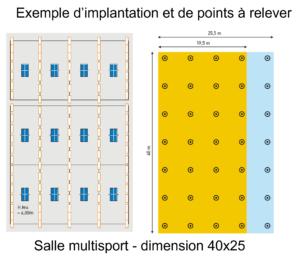
In order to save on your energy bill, we have created the VariBOX for you.
During a gymnasium or multi-sports hall lighting renovation project, we observe approximately 50% energy savings by replacing the projectors.
Coupled with a VariBOX adapted to your needs, this reduction in consumption can reach up to 80% savings.
Common brightness levels
This is possible by setting the right lighting levels according to the sports practiced as well as the options required for your sports equipment.
Recommended options for gymnasium lighting management
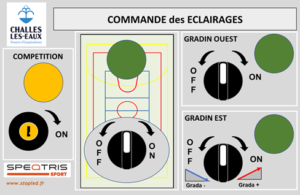
The different useful options for gymnasiums
Municipal gymnasiums, or multi-sports halls, are very often lit all day long to allow the practice of sports such as handball, basketball, volleyball, tennis, or badminton and other internal sports.
Gymnasium, multi-sports hall or multi-sports hall type infrastructures are used for school activities, sports associations and municipal services. To calibrate the lighting of these halls, we take into account all of these elements and adapt the lighting to the most dominant sporting activity on the site.
Below are some options that are frequently found in gymnasiums:
On sites such as high-level arenas, we can integrate a lighting animation solution in DMX version into the lighting management.
These are preconfigured programs, allowing you to create animation in the room around the different events.
With the VariBOX Animation, we provide a remote control, or a desk to allow the triggering of animations according to the sports and event agenda.
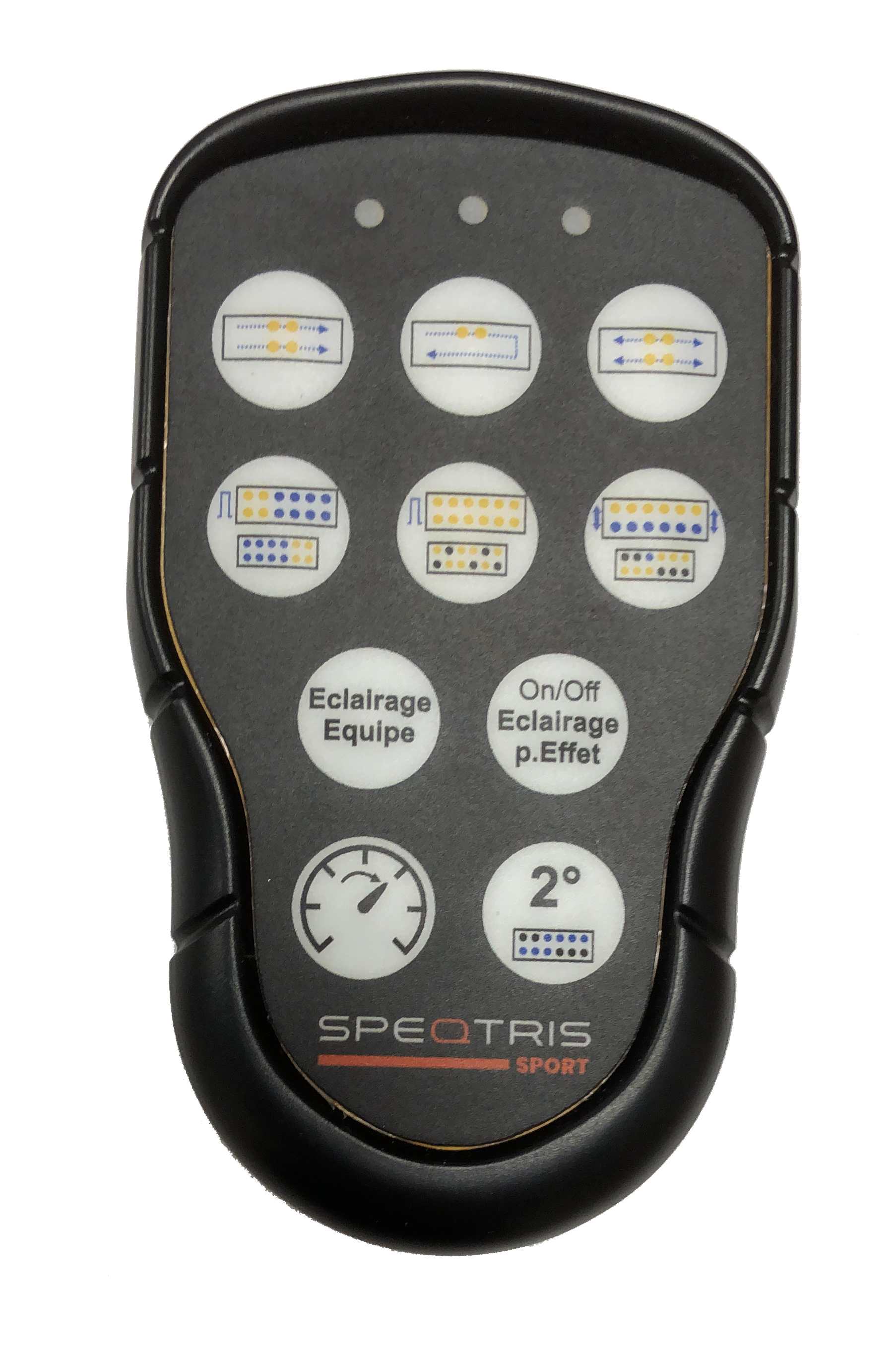
With over 13 years of field experience and achievements, we have designed here a panel of lighting layouts and installations according to each sport through our sports guide.
This tool will allow you to quickly find the photometric studies corresponding to your project and to define and propose the appropriate equipment for the desired lighting result.